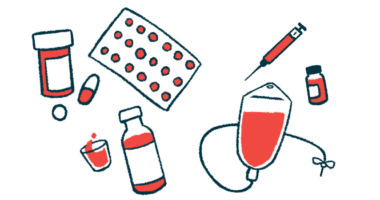Takhzyro Boosts Life Quality in French Patients With Early Access

Takhzyro (lanadelumab) led to significant benefits for patients with hereditary angiodema (HAE) in France who received the therapy as part of an early-access program prior to its approval in Europe, a study has found.
The treatment “reduced attack rates, improved quality of life, and was generally well tolerated,” the investigators wrote, noting these findings are consistent with data from several other clinical trials.
The study, “Long-term prophylaxis with lanadelumab for HAE: authorization for temporary use in France,” was published in the journal Allergy, Asthma & Clinical Immunology.
Takhzyro is approved in several countries to prevent swelling attacks in HAE patients, 12 and older, based on safety and efficacy results from the Phase 3 HELP trial (NCT02586805) and its open-label extension (NCT02741596).
Prior to Takhzyro’s approval in December 2018 by the European Commission, the therapy’s developer, Shire (now part of Takeda), was granted an authorization for temporary use (ATU) in France. This allowed Takhzyro to be used to prevent HAE attacks in patients, 12 and older, for whom other treatments had been ineffective or were unavailable. The program received requests for the therapy from October 2018 to March 2019.
In the new study, a research team in France reported on the safety and efficacy of the therapy under the program.
Participants self-administered Takhzyro (under-the-skin injections at a dose of 300 mg) every two weeks. Other treatments were being used in 78% of patients immediately prior to the study, all of whom agreed to stop them before starting Takhzyro.
The study included 77 adults from 18 to 64 years of age, most (69%) of them female. The participants received at least one dose of Takhzyro, with dosage modified in 12 cases by the patient’s clinician at some point.
When the study ended in 2019, participants had been exposed to the treatment for a mean of 240.4 days (nearly eight months). Follow-up periods among the participants were highly variable, with 69 people returning for a first follow-up after roughly three months, and 39 returning for a second follow-up around six months.
In the six months prior to starting treatment, patients experienced a mean of 2.68 attacks per month. This rate declined significantly to 0.16 per month at the first follow-up visit after they started the treatment (around 3 months), which was largely maintained until the end of the study.
After six months of treatment, 66% of participants who returned for follow-up had not experienced any attacks. Overall, fewer attacks occurred after 70 days of treatment (between two to three months), with 77% of patients having no attacks between day 70 and six months.
This is consistent with the notion that the treatment reaches steady-state therapeutic levels in the bloodstream around that time, the researchers noted.
The Angiodema Activity Score (AAS) was used to assess symptom severity and burden in monthly cycles, with lower scores reflecting less disease activity, and a score of zero reflecting no disease attacks.
The proportion of patients with an AAS score of zero was significantly higher after treatment initiation than at the start, indicating a reduced disease burden, the researchers wrote.
Further, 55.3% of participants experienced clinically significant quality-of-life improvements after three months, which reached 64.5% by six months. Patients who experienced more attacks were less likely to experience meaningful improvements in their quality of life.
Prior treatment with human plasma-derived C1-INH — the protein defective or deficient in HAE — did not influence responses to treatment.
During the study period, 96 adverse events were reported in 46 patients, and none were considered serious. Headache and injection site pain were the most common side effects.
Most patients (71%) also reported that they found learning to self-administer the medication easy, and were generally satisfied with the ease of administration.
Overall, these findings support previous data that showed Takhzyro’s safety and effectiveness in preventing attacks in HAE patients.
“These results and patient experiences confirm those demonstrated in the pivotal HELP Study and HELP [open label extension], thus helping to establish the effectiveness and safety of [Takhzyro] in the prevention of HAE attacks,” the team wrote.
“As the armamentarium of targeted treatments grows, the goals of therapy and models of care for HAE are shifting toward achievement of complete control of disease (i.e., attack-free periods), with minimal impact of disease on [quality of life],” the researchers wrote. “The positive findings from the current study show further support that [Takhzyro] can help achieve these goals.”
They noted, however, that the study is limited by variable follow-up schedules leading to some missing data, particularly at the six-month time-point.
An ongoing observational real-world study called SERENITI is currently evaluating the safety and efficacy of Takhzyro in French HAE patients who received at least one dose of the medication after October 2018 — most of whom also participated in the ATU program. That study is expected to end in April 2024.








